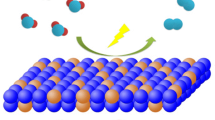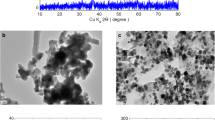Abstract
Oxygen evolution reaction (OER) is the key step involved both in water splitting devices and rechargeable metal-air batteries, and hence, there is an urgent need for a stable and low-cost material for efficient OER. In the present investigation, Co−Fe−Ga−Ni−Zn (CFGNZ) high entropy alloy (HEA) has been utilized as a low-cost electrocatalyst for OER. Herein, after cyclic voltammetry activation, CFGNZ-nanoparticles (NPs) are covered with oxidized surface and form high entropy (oxy) hydroxides (HEOs), exhibiting a low overpotential of 370 mV to achieve a current density of 10 mA/cm2 with a small Tafel slope of 71 mV/dec. CFGNZ alloy has higher electrochemical stability in comparison to state-of-the art RuO2 electrocatalyst as no degradation has been observed up to 10 h of chronoamperometry. Transmission electron microscopy (TEM) studies after 10 h of long-term chronoamperometry test showed no change in the crystal structure, which confirmed the high stability of CFGNZ. The density functional theory (DFT) based calculations show that the closeness of d(p)-band centers to the Fermi level (EF) plays a major role in determining active sites. This work highlights the tremendous potential of CFGNZ HEA for OER, which is the primary reaction involved in water splitting.

Similar content being viewed by others
References
Tahir, M.; Pan, L.; Idrees, F.; Zhang, X. W.; Wang, L.; Zou, J. J.; Wang, Z. L. Electrocatalytic oxygen evolution reaction for energy conversion and storage: A comprehensive review. Nano Energy 2017, 37, 136–157.
McCrory, C. C.; Jung, S.; Peters, J. C.; Jaramillo, T. F. Benchmarking heterogeneous electrocatalysts for the oxygen evolution reaction. J. Am. Chem. Soc. 2013, 135, 16977–16987.
Lee, Y.; Suntivich, J.; May, K. J.; Perry, E. E.; Shao-Horn, Y. Synthesis and activities of rutile IrO2 and RuO2 nanoparticles for oxygen evolution in acid and alkaline solutions. J. Phys. Chem. Lett. 2012, 3, 399–404.
Burke, M. S.; Enman, L. J.; Batchellor, A. S.; Zou, S. H.; Boettcher, S. W. Oxygen evolution reaction electrocatalysis on transition metal oxides and (oxy) hydroxides: Activity trends and design principles. Chem. Mater. 2015, 27, 7549–7558.
Kumar Katiyar, N.; Biswas, K.; Yeh, J. W.; Sharma, S.; Sekhar Tiwary, C. A perspective on the catalysis using the high entropy alloys. Nano Energy 2021, 88, 106261.
Amiri, A.; Shahbazian-Yassar, R. Recent progress of high-entropy materials for energy storage and conversion. J. Mater. Chem. A 2021, 9, 782–823.
Nellaiappan, S.; Katiyar, N. K.; Kumar, R.; Parui, A.; Malviya, K. D.; Pradeep, K. G.; Singh, A. K.; Sharma, S.; Tiwary, C. S.; Biswas, K. High-entropy alloys as catalysts for the CO2 and CO reduction reactions: Experimental realization. ACS Catal. 2020, 10, 3658–3663.
Katiyar, N. K.; Nellaiappan, S.; Kumar, R.; Malviya, K. D.; Pradeep, K. G.; Singh, A. K.; Sharma, S.; Tiwary, C. S.; Biswas, K. Formic acid and methanol electro-oxidation and counter hydrogen production using nano high entropy catalyst. Mater. Today Energy 2020, 16, 100393.
Kumar, N.; Tiwary, C. S.; Biswas, K. Preparation of nanocrystalline high-entropy alloys via cryomilling of cast ingots. J. Mater. Sci. 2018, 53, 13411–13423.
Qiu, H. J.; Fang, G.; Gao, J. J.; Wen, Y. R.; Lv, J.; Li, H. L.; Xie, G. Q.; Liu, X. J.; Sun, S. H. Noble metal-free nanoporous high-entropy alloys as highly efficient electrocatalysts for oxygen evolution reaction. ACS Mater. Lett. 2019, 1, 526–533.
Ding, Z. Y.; Bian, J. J.; Shuang, S.; Liu, X. D.; Hu, Y. C.; Sun, C. W.; Yang, Y. High entropy intermetallic-oxide core-shell nanostructure as superb oxygen evolution reaction catalyst. Adv. Sustain. Syst. 2020, 4, 1900105.
Nandan, R.; Rekha, M. Y.; Devi, H. R.; Srivastava, C.; Nanda, K. K. High-entropy alloys for water oxidation: A new class of electrocatalysts to look out for. Chem. Commun. 2021, 57, 611–614.
Katiyar, N. K.; Biswas, K.; Tiwary, C. S. Cryomilling as environmentally friendly synthesis route to prepare nanomaterials. Int. Mater. Rev., in press, DOI: https://doi.org/10.1080/09506608.2020.1825175.
Kumar, N.; Biswas, K. Fabrication of novel cryomill for synthesis of high purity metallic nanoparticles. Rev. Sci. Instrum. 2015, 86, 083903.
Katiyar, N. K.; Biswas, K.; Tiwary, C. S.; Machado, L. D.; Gupta, R. K. Stabilization of a highly concentrated colloidal suspension of pristine metallic nanoparticles. Langmuir 2019, 35, 2668–2673.
Kresse, G.; Hafner, J. Ab initio molecular dynamics for liquid metals. Phys. Rev. B 1993, 47, 558–561.
Perdew, J. P.; Burke, K.; Ernzerhof, M. Generalized gradient approximation made simple. Phys. Rev. Lett. 1996, 77, 3865–3868.
Zunger, A.; Wei, S. H.; Ferreira, L. G.; Bernard, J. E. Special quasirandom structures. Phys. Rev. Lett. 1990, 65, 353–356.
Urs, K. M. B.; Katiyar, N. K.; Kumar, R.; Biswas, K.; Singh, A. K.; Tiwary, C. S.; Kamble, V. Multi-component (Ag−Au−Cu−Pd−Pt) alloy nanoparticle-decorated p-type 2D-molybdenum disulfide (MoS2) for enhanced hydrogen sensing. Nanoscale 2020, 12, 11830–11841.
Grosvenor, A. P.; Biesinger, M. C.; Smart, R. S. C.; McIntyre, N. S. New interpretations of XPS spectra of nickel metal and oxides. Surf. Sci. 2006, 600, 1771–1779.
Fujii, T.; De Groot, F. M. F.; Sawatzky, G. A.; Voogt, F. C.; Hibma, T.; Okada, K. In situ XPS analysis of various iron oxide films grown by NO2-assisted molecular-beam epitaxy. Phys. Rev. B 1999, 59, 3195–3202.
Tan, B. J.; Klabunde, K. J.; Sherwood, P. M. A. XPS studies of solvated metal atom dispersed (SMAD) catalysts. Evidence for layered cobalt-manganese particles on alumina and silica. J. Am. Chem. Soc. 1991, 113, 855–861.
Carli, R.; Bianchi, C. L. XPS analysis of gallium oxides. Appl. Surf. Sci. 1994, 74, 99–102.
Petitmangin, A.; Gallas, B.; Hebert, C.; Perrière, J.; Binet, L.; Barboux, P.; Portier, X. Characterization of oxygen deficient gallium oxide films grown by PLD. Appl. Surf. Sci. 2013, 278, 153–157.
Du, X. F.; Zhao, H. L.; Lu, Y.; Zhang, Z. J.; Kulka, A.; Świerczek, K. Synthesis of core-shell-like ZnS/C nanocomposite as improved anode material for lithium ion batteries. Electrochim. Acta 2017, 228, 100–106.
Dai, W. J.; Lu, T.; Pan, Y. Novel and promising electrocatalyst for oxygen evolution reaction based on MnFeCoNi high entropy alloy. J. Power Sources 2019, 430, 104–111.
Chen, D. J.; Chen, C.; Baiyee, Z. M.; Shao, Z. P.; Ciucci, F. Nonstoichiometric oxides as low-cost and highly-efficient oxygen reduction/evolution catalysts for low-temperature electrochemical devices. Chem. Rev. 2015, 115, 9869–9921.
Katsounaros, I.; Cherevko, S.; Zeradjanin, A. R.; Mayrhofer, K. J. J. Oxygen electrochemistry as a cornerstone for sustainable energy conversion. Angew. Chem., Int. Ed. 2014, 53, 102–121.
Lide, D. R. CRC Handbook of Chemistry and Physics, Editor-in-Chief; CRC Press: London, 2005.
Nørskov, J. K.; Rossmeisl, J.; Logadottir, A.; Lindqvist, L.; Kitchin, J. R.; Bligaard, T.; Jónsson, H. Origin of the overpotential for oxygen reduction at a fuel-cell cathode. J. Phys. Chem. B 2004, 108, 17886–17892.
Nandan, R.; Devi, H. R.; Kumar, R.; Singh, A. K.; Srivastava, C.; Nanda, K. K. Inner sphere electron transfer promotion on homogeneously dispersed Fe-Nx centers for energy-efficient oxygen reduction reaction. ACS Appl. Mater. Interfaces 2020, 12, 36026–36039.
Kumar, R.; Das, D.; Singh, A. K. C2N/WS2 van der Waals type-II heterostructure as a promising water splitting photocatalyst. J. Catal. 2018, 359, 143–150.
Kumar, R.; Singh, A. K. Electronic structure based intuitive design principle of single-atom catalysts for efficient electrolytic nitrogen reduction. ChemCatChem 2020, 12, 5456–5464.
Bockris, J. O. M.; Otagawa, T. The electrocatalysis of oxygen evolution on perovskites. J. Electrochem. 1984, 131, 290–302.
Sun, W.; Song, Y.; Gong, X. Q.; Cao, L. M.; Yang, J. An efficiently tuned d-orbital occupation of IrO2 by doping with Cu for enhancing the oxygen evolution reaction activity. Chem. Sci. 2015, 6, 4993–4999.
Matsumoto, Y.; Sato, E. Electrocatalytic properties of transition metal oxides for oxygen evolution reaction. Mater. Chem. Phys. 1986, 14, 397–426.
Seh, Z. W.; Kibsgaard, J.; Dickens, C. F.; Chorkendorff, I.; Nørskov, J. K.; Jaramillo, T. F. Combining theory and experiment in electrocatalysis: Insights into materials design. Science 2017, 355, eaad4998.
Nørskov, J. K.; Abild-Pedersen, F.; Studt, F.; Bligaard, T. Density functional theory in surface chemistry and catalysis. Proc. Natl. Acad. Sci. USA 2011, 108, 937–943.
Acknowledgements
The authors would like to thanks SERB-DST for financial support to carry out this research. We would also like to thank the Imaging centre facilities at the Indian Institute of Technology Kanpur for TEM imaging. We acknowledge Advanced Materials Research Centre (AMRC), IIT Mandi to provide the sophisticated instrumentation facilities. A. P., R. K., and A. K. S. acknowledge Materials Research Centre, Solid State and Structural Chemistry Unit, and Supercomputer Education and Research Centre for providing the computational facilities. A. P., R. K., and A. K. S. also acknowledge the support from the Institute of Eminence (IoE) MHRD grant of the Indian Institute of Science. N. K. K. acknowledges the Newton Fellowship award from the Royal Society UK (NIFR1191571). C. S. T. thanks MHRD STARS for funding. C. S. T. acknowledges Science and Engineering Research Board of the Department of Science and Technology, Government of India, for support through the core research grant and Ramanujan Fellowship. C. S. T. acknowledges AOARD grant no. FA2386-19-1-4039.
Author information
Authors and Affiliations
Corresponding authors
Electronic Supplementary Material
Rights and permissions
About this article
Cite this article
Sharma, L., Katiyar, N.K., Parui, A. et al. Low-cost high entropy alloy (HEA) for high-efficiency oxygen evolution reaction (OER). Nano Res. 15, 4799–4806 (2022). https://doi.org/10.1007/s12274-021-3802-4
Received:
Revised:
Accepted:
Published:
Issue Date:
DOI: https://doi.org/10.1007/s12274-021-3802-4




